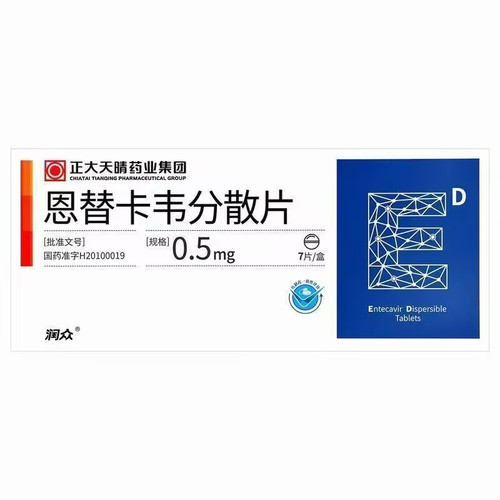Product Overview
[Drug Name]
Generic Name: Entecavir Tablets
Trade Name: Zuo Xin Yue Entecavir Tablets 0.5mg*28 Tablets
Pinyin Code: Zuo Xin Yue En Ti Ka Wei Pian 0.5mg 28 Tablets
[Main Ingredient]
The main ingredient of this product is entecavir. Chemical Name: 2-Amino-9-{(1S,3R,4S)-4-hydroxy-3-hydroxymethyl-2-methylenecyclopentyl]-1,9-dihydro-6H-purin-6-one monohydrate. Molecular Formula:
C12H15N503-H20. Molecular Weight: 295.3
[Properties]
This product is a film-coated tablet. After removing the coating, it appears white or off-white.
[Indications/Main Functions]
Entecavir is indicated for the treatment of chronic hepatitis B in adults (including patients with compensated and decompensated liver disease) with active viral replication, persistently elevated serum alanine aminotransferase (ALT) levels, or active liver histological lesions. It is also indicated for the treatment of nucleoside-naive children aged 2 to <18 years with chronic HBV infection and compensated liver disease who have evidence of active viral replication, persistently elevated serum ALT levels, or histological evidence of moderate to severe inflammation and/or fibrosis. For specific instructions, see [Dosage and Administration].
[Specifications]
0.5 mg x 28 tablets
[Dosage and Administration]
Entecavir should be taken under the guidance of an experienced physician. Entecavir should be taken on an empty stomach (at least 2 hours before or after a meal). Recommended dose: Adults, 0.5 mg of entecavir orally once daily. Patients who develop viremia or develop lamivudine-resistant mutations during lamivudine treatment should receive 1.0 mg (two 0.5 mg tablets) once daily. Patients with decompensated liver disease should receive 1.0 mg (two 0.5 mg tablets) once daily. Children weighing 32.6 kg or more should receive 0.5 mg of lamivudine daily, while those weighing greater than 10 kg and less than 32.6 kg should receive the oral solution. Treatment decisions for children should carefully consider individual patient needs and refer to current pediatric treatment guidelines, including baseline histological information. The benefits of long-term virologic suppression with continuous therapy must be weighed against the risks of extended treatment, including the emergence of drug-resistant HBV. For HBeAg-positive children with compensated chronic hepatitis B, elevated serum ALT levels should have persisted for at least 6 months prior to treatment; for HBeAg-negative children, elevated serum ALT levels should have persisted for at least 12 months prior to treatment. The optimal duration of treatment for pediatric patients is unknown. According to current pediatric treatment guidelines, discontinuation of treatment may be considered in the following circumstances: * For HBeAg-positive patients, treatment should continue until undetectable HBV DNA levels and HBeAg seroconversion (HBeAg loss and anti-HBe positivity in two consecutive serum samples at least 3-6 months apart) for at least 12 months, or until HBsAg seroconversion or loss of efficacy. Serum ALT and HBV DNA levels should be monitored regularly after discontinuation of treatment (see [Precautions]). * For HBeAg-negative patients, treatment should continue until HBsAg seroconversion or evidence of loss of efficacy. Pharmacokinetic studies have not been conducted in pediatric patients with renal or hepatic impairment. Renal Impairment: In patients with renal impairment, the apparent oral clearance of entecavir decreases with decreasing creatinine clearance (see [Pharmacokinetics]). The dose should be adjusted for patients with creatinine clearance <50 mL/minute, including those receiving hemodialysis or continuous ambulatory peritoneal dialysis (CAPD). For oral solution dosage adjustments, refer to the oral solution package insert. If oral solution is unavailable, the dose can be adjusted by extending the dosing interval as an alternative treatment, as detailed in Table 1. The recommended dosage adjustments are based on inferences from limited data, and their safety and efficacy have not been clinically evaluated. Therefore, virological response should be closely monitored. (See package insert for other details.)
[Adverse Reactions]
See package insert for details.
[Contraindications]
Entecavir is contraindicated in patients with hypersensitivity to entecavir or any of the ingredients in the formulation.
[Precautions]
Warning 1. Severe Acute Exacerbation of Hepatitis B: Severe acute exacerbations of hepatitis B have been reported in patients who discontinue hepatitis B antiviral therapy (including entecavir). Patients who discontinue hepatitis B antiviral therapy should have their liver function closely monitored for at least several months. If necessary, antiviral therapy should be reinitiated. 2. HIV Co-infection: Entecavir has not been evaluated in patients with HBV and HIV co-infection who are not receiving effective HIV treatment. Limited clinical experience suggests that entecavir may develop resistance to HIV nucleoside reverse transcriptase inhibitors if used in patients with chronic hepatitis B and HIV infection who are not receiving antiretroviral therapy. Therefore, entecavir is not recommended for patients with HBV co-infection and HIV who are not receiving highly active antiretroviral therapy (HAART). All patients should be tested for HIV antibodies before starting entecavir treatment. Entecavir has not been studied for the treatment of HIV infection, and therefore, entecavir is not recommended for HIV treatment. 3. Lactic Acidosis and Severe Hepatomegaly with Steatosis: Case reports of lactic acidosis, hepatomegaly with steatosis, and even death have occurred following nucleoside analog therapy alone or in combination with antiretroviral drugs. The majority of patients experiencing these events are women. Obesity and prolonged use of nucleoside drugs may be risk factors for these adverse events. Patients with these risk factors should exercise caution when using nucleoside analogs for liver disease; however, such events have also occurred in patients without these risk factors. Lactic acidosis has been reported in patients receiving entecavir therapy, often associated with hepatic decompensation or other serious medical conditions or drug exposure. Patients with hepatic decompensation are at increased risk for lactic acidosis. Entecavir should be discontinued if clinical or laboratory findings suggest lactic acidosis or significant hepatotoxicity (which may include hepatomegaly and steatosis, even in the absence of significant elevations in aminotransferases). Precautions: For patients with renal impairment and creatinine clearance <50 mL/min, including those on hemodialysis or CAPD, an adjustment in the entecavir dose is recommended (see [Dosage and Administration]). The safety and efficacy of entecavir in liver transplant recipients is unknown. If entecavir therapy is considered necessary for a liver transplant recipient who has been or is currently receiving immunosuppressants that may affect renal function, such as cyclosporine or tacrolimus, renal function should be closely monitored before and during entecavir administration. (See Pharmacokinetics.) Special Considerations for Patients with Drug Resistance and Lamivudine Failure: Mutations in lamivudine-resistant sites in the HBV polymerase region may lead to secondary mutations, including mutations in sites associated with entecavir resistance. A small number of patients who failed lamivudine had baseline mutations in the entecavir-resistance-associated sites rtT184, rtS202, and rtM250. Patients with lamivudine resistance are at increased risk for subsequent development of entecavir resistance compared with those without lamivudine resistance. In studies of lamivudine failure, the cumulative incidence of genotypic entecavir resistance after 1, 2, 3, 4, and 5 years of entecavir treatment was 6%, 15%, 36%, 47%, and 51%, respectively. Lower virologic response rates (HBV DNA <501U/mL) were observed in pediatric patients with a baseline HBV DNA level of 8.0 log101U/mL. Entecavir should be used in these patients only if the potential benefits outweigh the risks to the child (e.g., resistance). Because some children may require long-term, or even lifelong, treatment for chronic active hepatitis B, the impact of entecavir on future treatment options should be considered. Patients should take entecavir under their doctor's supervision and inform their doctor of any new symptoms and concomitant medications. Patients should be informed that discontinuation of entecavir can sometimes lead to worsening liver disease, and therefore should consider changing treatment under their doctor's guidance. Patients should undergo HIV antibody testing before starting entecavir treatment. Patients should be informed that if they are infected with HIV and not receiving effective HIV medication, entecavir may increase the risk of developing resistance to HIV medication. Entecavir treatment does not reduce the risk of HBV transmission through sexual contact or contaminated blood. Therefore, appropriate precautions should be taken. Do not use if the inner packaging is opened or damaged.







